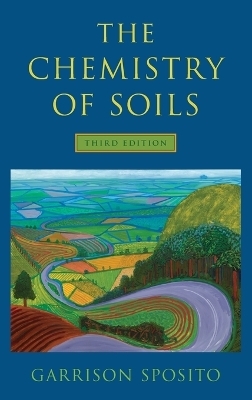
The Chemistry of Soils
Oxford University Press Inc (Verlag)
978-0-19-063088-1 (ISBN)
The second edition of The Chemistry of Soils, published in 2008, has been used as a main text in soil-science courses across the world, and the book is widely cited as a reference for researchers in geoscience, agriculture, and ecology. The book introduces soil into its context within geoscience and chemistry, addresses the effects of global climate change on soil, and provides insight into the chemical behavior of pollutants in soils. Since 2008, the field of soil science has developed in three key ways that Sposito addresses in this third edition. For one, research related to the Critical Zone (the material extending downward from vegetation canopy to groundwater) has undergone widespread reorganization as it becomes better understood as a key resource to human life. Secondly, scientists have greatly increased their understanding of how organic matter in soil functions in chemical reactions. Finally, the study of microorganisms as they relate to soil science has significantly expanded.
The new edition is still be comprised of twelve chapters, introducing students to the principal components of soil, discussing a wide range of chemical reactions, and surveying important human applications. The chapters also contain completely revised annotated reading lists and problem sets.
Gary Sposito was the former Chair in Soil Science and is now Professor Emeritus of Ecosystem Sciences and Environmental Engineering, University of California, Berkeley.
1 The Composition of Soils
1.1 Natural Capital
1.2 Soil Pore Fluids
1.3 Soil Minerals as Nutrient Capital
1.4 How Minerals Weather
1.5 Soil Humus as Nutrient Capital
For Further Reading
Problems
2 Soil Minerals
2.1 How Mineral Structures Form
2.2 Primary Silicates as Nutrient Capital
2.3 Clay Minerals and Cation Retention
2.4 Metal Oxide Minerals and Ion Retention
2.5 Soil Carbonates and Sulfates
For Further Reading
Problems
3 Soil Humus
3.1 Biomolecules in Humus
3.2 Humus Composition
3.3 Stabilizing Soil Humus
3.4 Humus Buffering
3.5 Reactions with Organic Chemicals
For Further Reading
Problems
4 The Soil Solution
4.1 Sampling Soil Solutions
4.2 Soluble Complexes
4.3 Chemical Speciation
4.4 Calculating Chemical Speciation
4.5 Calculating Conditional Stability Constants
For Further Reading
Problems
5 Mineral Weathering
5.1 Mineral Dissolution
5.2 Mineral Weathering Sequences
5.3 Mineral Stability during Weathering
5.4 The GLO Step Rule
5.5 Phosphate Transformations in Calcareous Soils
For Further Reading
Problems
6 Oxidation-Reduction Reactions
6.1 Flooded Soils
6.2 Understanding Transformations in Flooded Soils
6.3 Generalizing the Sequence: The Redox Ladder
6.4 Exploring the Redox Ladder
6.5 pE-pH Diagrams
For Further Reading
Problems
7 Soil Particle Surface Charge
7.1 Structural Charge
7.2 Stern Layer Charge
7.3 Surface Charge
7.4 Points of Zero Charge
7.5 Schindler Diagrams
For Further Reading
Problems
8 Soil Adsorption Phenomena
8.1 Measuring Adsorption
8.2 Modeling Adsorption
8.3 Understanding Metal Cation Adsorption
8.4 Understanding Anion Adsorption
8.5 Surface Redox Processes
For Further Reading
Problems
9 Exchangeable Ions
9.1 Defining Exchange Capacity
9.2 Defining Exchange Isotherms
9.3 Understanding Ion Exchange Selectivity
9.4 Toxic Metals in Soils: Biotic Ligand Model
9.5 Humus Buffering: NICA-Donnan Model
For Further Reading
Problems
10 Soil Colloids
10.1 Defining Soil Colloids
10.2 Understanding Flocculation
10.3 Rapid Flocculation: The Schulze-Hardy Rule
10.4 Rapid Flocculation and Ionicity
10.5 Slow Flocculation
For Further Reading
Problems
11 Soil Acidity
11.1 Proton Cycling and Soil pH
11.2 Acid-Neutralizing Capacity
11.3 The Problem of Aluminum
11.4 Redox Reactions and Soil pH
11.5 Neutralizing Soil Acidity
For Further Reading
Problems
12 Soil Salinity
12.1 Exploring Saline Soil Solutions
12.2 Sodicity and Salinity
12.3 Mineral Weathering in Arid-Zone Soils
12.4 The Problem of Boron
12.5 Irrigation Water Quality
For Further Reading
Problems
| Erscheinungsdatum | 30.11.2016 |
|---|---|
| Zusatzinfo | 67 |
| Verlagsort | New York |
| Sprache | englisch |
| Maße | 157 x 236 mm |
| Gewicht | 522 g |
| Themenwelt | Naturwissenschaften ► Biologie ► Biochemie |
| Naturwissenschaften ► Chemie | |
| Naturwissenschaften ► Geowissenschaften ► Geologie | |
| Weitere Fachgebiete ► Land- / Forstwirtschaft / Fischerei | |
| ISBN-10 | 0-19-063088-4 / 0190630884 |
| ISBN-13 | 978-0-19-063088-1 / 9780190630881 |
| Zustand | Neuware |
| Haben Sie eine Frage zum Produkt? |
aus dem Bereich


